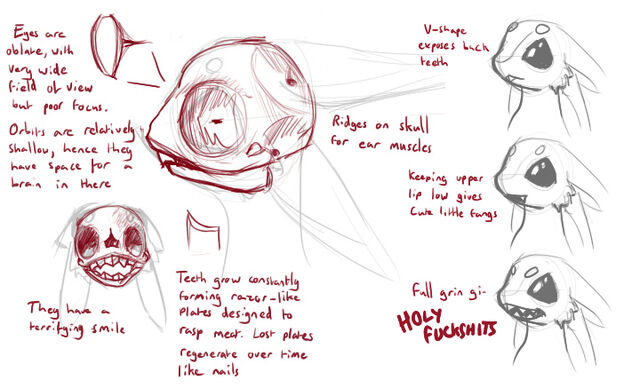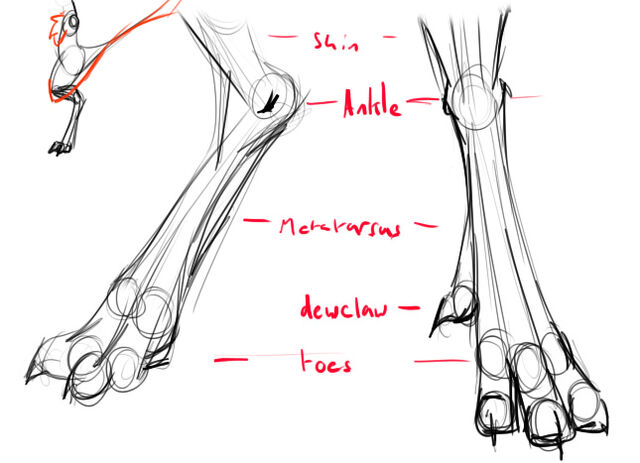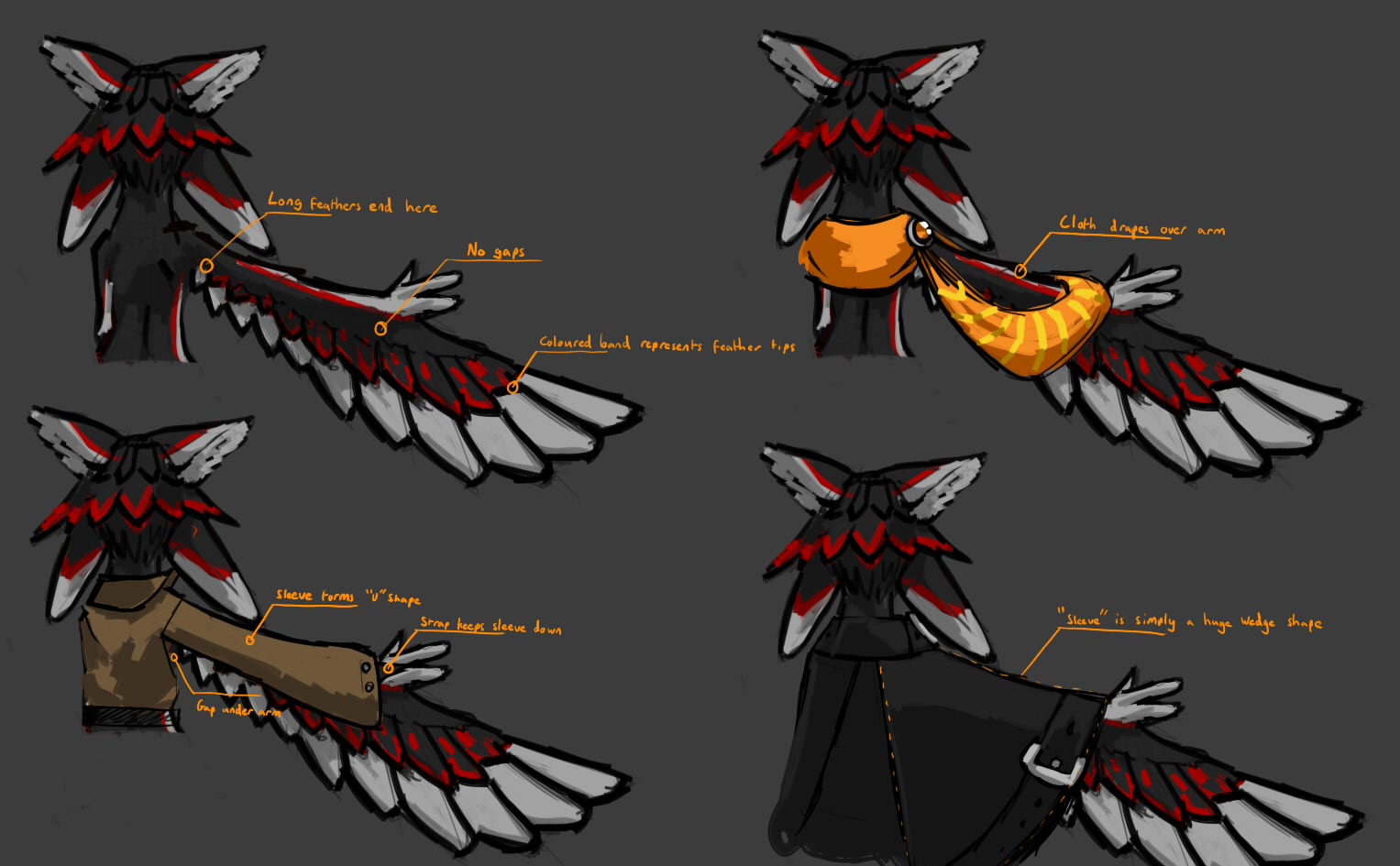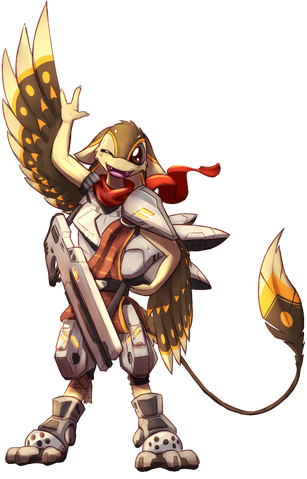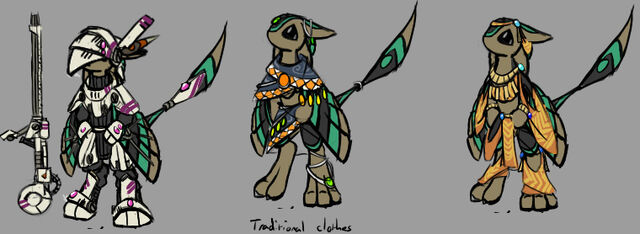Name of nation: A Lorca Ghaj (Eng: The Lorca Imperium)
Species: Lorca are muscular and tall, usually standing between 2.23 and 2.57 meters. Their jaws are quadruple-hinged, with an upper jaw and four lower mandibles arranged in two tiers. Mandible and upper jaw structure along with teeth shape and numbers result from different phenotypes, usually relative to ethnicity. They are still compatible with other members of the species, however. These mandibles have between eight and twelve teeth each and some Lorca, those whose descent is from the Lorca inhabitants of Sarudun, have an additional, larger fang on the tips of each mandible. Anywhere from eight to more than a dozen broader teeth may be mounted on the upper jaw structure. This structure will likely make it harder for them to speak alien languages, and vice versa, as some of the pronunciation is through mandible positioning which most other species lack, and as the Lorca have mandibles they have no lips to position to make certain sounds. They are omnivores however they are more inclined towards eating meat and their body is more adapted towards carnivorous. Lorca smell with the use of two nostrils, each slightly in front of and below the eye socket. Given their predatory nature, their sense of smell is very developed.
Their hands are tetradactyl, each having two fingers in the middle and an opposable thumb on either side. Their legs are digitigrade, with short upper and lower legs, using the two phalanges in their legs to support their weight when walking. This arrangement allows them to run very quickly and jump large distances. Their agility may also be attributed to their homeworld's high gravity (Which is 1.6G); the additional strength required to move normally in a higher-gravity environment would cause them to be more powerful in lower gravity situations. They also have a double set of pectoral muscles, which contributes to their notable strength. As an aside, their digitigrade stance makes it difficult for them to climb ladders
Lorca have a circulatory system in which two hearts pump indigo-colored blood, as their blood has a high level of hemoglobin. This higher level of hemoglobin and secondary heart is used to offset their larger size. Through a rare birth defect, they are sometimes born with only a single heart and while they will survive with only a single heart, they have much less stamina than their two hearted brethren. They breathe oxygen and their homeworld has a nitrogen-oxygen atmosphere.
Lorca have gray scaley skin, though those descended from the inhabitants of the Arusa subcontinent are a gray-brown colour. They have forward-facing eyes with vertical slits and horizontal eyelids that are reptilian in nature, giving them high-resolution central vision and depth perception. Interestingly, they have 4 types of cone cells in the eyes, however in most only three of these function correctly, the nerve ending in the fourth cone does not transmit to the brain. However, those descended from the inhabitants of the Arusa sub-continent or the Tauri islands have a fully function fourth cone, allowing them to see ultra-violet light spectrums. The arts are a popular "hobby" among those descended Arusa and Tauri because their bright paintings resulting from the way they see the world can sell for relatively high amounts, so Arusa and Tauri artists are among the more prosperous. The Lorca have approximately 130 million rod cells in their eyes. Their eyes are almost universally colored an yellow-orange.
Lorca exhibit minor sexual dimorphism, with the females being slightly smaller than the males and they are oviparous, laying eggs rather than giving live birth. The species is remarkably long-lived; Lorca over 70-80 years of age are usually fit for combat duty and their average life span is currently around 124 years. They also possess the ability to regrow lost limbs over a period of several months if properly fed
Description of government: An meritocratic Oligarchy. The government structure favours achievement over anything else. Physical and mental achievements are highly prized, the culture having woven their religion into these achievements, perhaps some ancient attempt at manipulation on a massive scale. Given their proud warrior culture it is perhaps inevitable that the military holds a considerable degree of power (indeed, all are trained from birth to fight so they can be called on if need be). At the top of the government is the high council, a body composed of three High Councillors. These councillors are elected by the council and then adopt a new ceremonial name. Below them is the Council, composed of 200 councillors. These recieve a ceremonial suffix –Ax. Next come the lower councils and below them the Ministries. Both adopt the honourific suffix of –Oi
Description of military: Their military is a large structure of well trained and extremely zealous soldiers. The source of their bravery and courage can also be a limiting factor, causing excessive zeal in some units. Their ships often have religious or spiritual sounding names.
Starship classes
Layman class fighter/bomber: A fast, single man fighter/bomber, designed for the express purpose of hassling the enemy and destroying hostiles on the ground
Gaia class dropship: A ship made to carry soldiers into the fray. Named after the Gaia from mythology, a race of female spirits who brought the Lorca into the world. They were also believed to be responsible for delivering babies to the eggs. Probably the closest in Lorca mythology to angels
Drop pod: A device used to deliver soldiers or weapons into a fight on the ground... or more rarely, into enemy ships when the shields are down
Honour class Corvette: This small and agile ship is used primarily for recon, policing action and small scale engagements. It lacks the firepower of its larger brethren but makes up for it in speed
Burden class transport: Exactly what it says on the tin a transport ship.
Legionary Class Frigate: Essentially a larger version of the corvette, designed to take larger prey. It is a light, defense focussed ship.
Inquisitor Class Prowler: A smaller, lightly armed ship. Designed for speed and equipped with stealth equipment, it is meant to stay near to planets, asteroids or other such large objects and spy on enemy fleets, possibly watching a planet for an ample time for a fleet to launch an attack...
Warrior class Destroyer: The Warrior class destroyer is stronger than the previous classes, carrying a larger range of weapons. Both durable and fast, it's large array of weaponry and defensive systems makes it a devestating opponent, paticularly to larger ships.
Garg class Cruiser: Named after the ancient war mounts, the Garg is larger than the previous classes and the last class before being considered a capital ship.
Elder class Battle Ship: The first ship to abandon the "evasion" approach of it's smaller brethren, the Elder class can withstand more punishment that the preceeding ships and cause more damage. It is also the first of the ship classes to be a 'Capital' ship
Blessed class Carrier: A large ship designed with the express purpose of carrying massive numbers of land forces, Layman fighter-Bombers and small star ships. Resembling an oversized Burden Class, it is armed with large plasma cannons and will always be used in conjunction with an escort force.
Battlemaster Class Ship of the Line: The Battlemaster is a ship designed to take massive punishment, while being able to deal it back it back. Although Dreadnaughts are the strongest ships in the navy, the Battlemasters are generally the most powerful encountered, a battlefleet likely containing at least one.
Overlord Class Dreadnaughts: The most powerful ships in usage by the Ghaj, the Overlord class combines aspects of a Battlemaster and a Blessed class, able to perform both functions. A major investment, an overlord accompanying a fleet spells trouble for the target...
Technological Overview: The Ghaj has a highly militarily focused government, and as such they have some extremely advanced military technologies. They favor plasma weaponry as it will cauterize the wounds of the opponent as it melts through, thus reducing the amount of ‘honour’ the target will lose. Death through Anti-matter weaponry is also considered to be an honourable demise. Notable civic technologies include gravity lifts, gravity transport tubes, field bridges and other such applications. Most of these are derived from military technologies. Some technological advancements are slowed by their ideology, sometimes simply because upon creation nobody has used them as they feel they are dishonourable, though others have been focused on and over time they often show willingness to accept what they initially rejected.
Cultural Overview: Although they moved to a technologically advanced society and abandoned the old stone age tools, the ideals of honour were resistant to change. For most Lorca, an existence without honour is still worse than death.
Naturally, the way to gain honour in early society was through combat, and lacking an understanding of the world religions began to form around what has since been named in the common tongue of the Lorca as "A Kha o a Lor", or "The Path of the Warrior". It was believed that only those with honour would be admitted into paradise upon death, and that the honour of a family was also taken into account during the day of judgement. Naturally, the link was in time made between Family Honour and blood and as such honour became associated with blood. Since honour was carried in the blood, when one bleeds they are losing some of their honour. The spike of adrenaline during battle was said to be the feeling of honour rushing into the blood. Even though they now know the biology behind it and that blood carries no DNA, the traditions behind it still remain and some even contend that having an operation in shameful as it makes you "bleed without honour"
When the eggs are layed, most are turned over and the raised by the "Shapers" of the area. The young may have little communication with their parents or even none at all. These "Warrior Crèches'" are divided into Lances, which are the equivalent of squads in the Ghaj. Upon reaching the coming of age, the Lances are transferred to the fields it is believed would suit them best. These Lances are kept together where possible, and usually regard each other as brothers. Youths who are part of a Warrior Crèche have the suffix of -oo. The shapers have suffixes relative to their field, there is no shaper suffix.
Members of the military have the suffix -oa. "Swordsmen" have the suffix -ei, which denotes nobility; All swordsmen are automatically made part of the nobility, however the title is not hereditary. Swordsmen are allowed to wield the Plasma Sword, a weapon that is valued highly. It is considered an honourable weapon for a Lorca to use as it requires them to get close to their opponent, and to meet your fate on the tip of a Plasma Sword is considered one of the "least dishonourable" ways to be killed in battle, as it cauterises the wound and as such prevents blood loss, thus minimising the loss of honour. The plasma sword works by containing super heated plasma within a magnetic field to form a "blade". It is devastating in combat, though it requires the user to be close to their target. There are other technologically advanced melee weapons that may see use in combat, though most are not held to such as high regard. The exception is the gravity stave, which is weilded by the Honour Guardsmen of the Ghaj. The gravity stave creates a gravity well around the tip of the stave, which if thrust into an opponent can cause them to implode. It is considered a dishonourable way to die, as it is obiously extremely messy 'As is a fitting fate for those who use less than honourable means in war'. This gravity well can also be focused to pull objects or even people towards the user. Honour Guardsmen of the Ghaj are often found protecting Councillors or important government structures, but may be assigned to the command of high ranking officers and some may take command themselves. Some high ranked military officers are also permitted to use gravity staves.
With the advent of technology and enlightenment, technological prowess has become a new avenue for gaining honour. It is considered that a scientist will share in any honour his ideas and technologies lead to the creation of.
"Lorca" is actually two words combined into one. Lor, which means warrior, and Ca, which means glory. Together, they become "Glorius Warrior"
The most commonly used language is o to as "The Standard Tongue", but this is misleading. The Standard Tongue contains five languages within it, which although are officially choices in vocabularly are closer to five different languages. They are:
"Black Tongue" This denotes hostility, anger, hatred or rivalry. Commonly used by Lorca soliders in the field to communicate or taunt the enemy, it is noticibly harsher than the four other tongues.
"The Grey Tongue" This is commonly used when talking to others who are not related or close friends.
"The White Tongue" It is only used when the Lorca feels the person they are talking to its trust worthy. Not as harsh as the previous two tongues, it lacks the cruel under tones and is used by certain offices, councils and in warrior creches to symbolise fraternity and trust.
"The Fair Tongue" Only used to talk to a lover. This tongue was, according to legend, gifted to the Lorca race when the great warrior queen Zira Lukax slayed all the "fell beasts" of Idun with her bare hands to save the object of her lover. Seeing their love overcoming the beasts of Idun, the ancestors gifted them the fair tongue and performed the first binding ritual. There is some truth in this story, Zira did lead a great campaign into Idun to defeat a rival kingdom, and she executed the enemy king with her bare hands. However, while she was married soon after, it is unknown whether her partner was freed from Idun or whether he had ever been to Idun. It’s likely an example of two events being woven together with myth and legend over the millennia
“The Honour Tongue” The Honour Tongue is a more religious tongue, used during binding rituals and other such religious events, as well as in the Council. The tongue is said to hold spiritual power
The core tenets of A Kha a o Lor are:
1: Honour
2: Rectitude
3: Mercy (Note that this doesn’t necessarily mean show mercy and let them live, and can instead be interpreted as ‘Mercy by spilling the least honour possible’ depending on the practitioner)
4: Valour
5: Loyalty
6: Wisdom
7: Respect (This includes respect for one’s self, respect for one’s own body and respect for others. It also covers gaining respect and maintaining that respect. Similar to Mercy, this doesn’t mean they won’t brutally kill you)
8: Integrity (This is a controversial one, which often causes squabbles in debating circles. Questions often raised include whether the use of stealth breaks this tenet and whether it is justifiable to break this tenet to uphold others.)
There are several lesser tenets that one is recommended to follow that will increase ones honour, however they are not requirements for entrance into the afterlife unlike the core tenets. It is believed by followed of the path, that one does not need to know of or believe in A Kha a o Lor to be accepted into the afterlife, they will be permitted to enter as long as they have lived by the tenets. It is said that those in the afterlife may return to help others follow the path, and as such ancestor worship plays a large part in A Kha a o Lor.
Historically, Burials were conducted by the transport of the dead on a ‘War vehicle’. Traditionally, this was to be a Garg (A vicious, horse sized beast) drawn chariot, though with the advent of motor technology it was common to use military transport vehicles rather than traditional methods. In the case of war dead or multiple dead within a family, they were transported side by side. If the person was a criminal or traitor, they would be tied to the back of a Garg or motor vehicle and dragged along the ground. They would progress out of the city and across the country until they reached the regions House of the Dead. Upon reaching the house of the dead, they were taken from their transport and carried inside, where they were laid out on the stone death beds within the “Room of the Dead”. In one hand was placed a ceremonial crafted weapon (Usually a sword, spear or bow), and in the other a tool from their profession (In the case of a soldier, they received a ceremonial shield). They were then left for 8 days, one day for each tenet and then burnt to ashes and placed into an urn, which was then interred in the catacombs. If the person was a criminal or traitor, they would instead be flayed by the priests and then their bones crushed into powder, which was scattered along the floor of the catacombs so that they were trodden on by visitors. Their meat would be fed to animals. This method has been used to bury the dead for thousands of years but with the advent of space travel, the Ghaj moved towards ‘Tomb Worlds’, entire planets dedicated to this purpose. There are two of these such worlds, and the majority of the dead are now sent to these worlds, though some traditional burials still occur. On these worlds, the dead are given a ceremonial weapon and a tool from their profession, then preserved in stasis so that they never go through the dishonor of rotting. On these tomb worlds, people of note are given their own chambers while the others are lined along the walls of the massive halls. The powdered bones of criminals are still strewn across the catacomb floors, and pits are maintained where the priests will throw the flayed skin to the beasts below. However, a new custom has developed based on old Tauri burial customs, and sometimes the bones of criminals are incorporated into the construction work. The priests are the only ones to live on these tomb worlds, and they double as tomb guards, making sure none who lack permission defile the tombs of the dead. Permission to see a family member must be gained through the military station in orbit, which refuse to set foot on the planet or allow others to set foot on it without permission from the priests. It is believed that any that land on the planet without permission will be cursed
History: Although the Lorca had evolved to chase and hunt creatures comparable in size to dogs, their natural prey did not move in herds but were generally solitary. As such, while individuals could feed themselves, supporting tribes was near impossible. As such Lorca relied on pack tactics to bring down much larger prey in order to feed their tribes in the prehistoric era. This, coupled with the dangers that many of their new prey posed, led to them relying on each other heavily. Over time, these strong brotherhoods created codes of honour, which became high in value.
The early Kingdoms (A arl Haj) were a series of small kingdoms set around the continent of Sarudun. Although other advanced civilizations rose on the other continents, the history of Sarudun is considered not only the most important (having been the most successful) but is also the best documented. There were three major kingdoms in the early days Idun, Dadun and Judak. It was in this period that the nobility was conceived and the code of honour developed by the hunting tribes evolved into a religion. The end of this period is marked by the fall of Idun. Idun fell when Queen Zira of the Dadun invaded and killed the king, seizing control of Idun and creating the first ‘Ghaj’, or empire.
This collapse prompted the beginning of a series of events that would lead to the discovery of the other continents by the exiles of Idun. Word would eventually reach Sarudun some 150 years later and so began the “great rush”, a period of time where the powers of Sarudun invaded and attempted to seize the foreign continents. Gunpowder was first discovered 110 years after the great rush began and as such Sarudun began to dominate faster and faster, though powers such as Dadun began to build close ties with powerful native nations rather than trying to invade them. The natives were quick adopters of gunpowder, particularly on the continent of Arusa, and so began the bloody decade long wars between natives and invaders. It was during this great rush that the “Binding Debate” began in Judak. The King Hiro wished to divorce his Queen Kira in favour of a younger and more attractive bride. The Queen was beloved by the people, however, and she was not about to be forced off her throne simply because she was barren. She contended that she had not only been a faithful queen but a proud warrior, and had expanded the Judak Haj personally into the new world. Her many military ventures had brought her great honour… more honour, whispers began, than her husband. The King was having none of this and so beseeched the Council of Elders. They told the two that the binding was for life. Kira did not wish to kill Hiro, however Judak could not afford for the debate to continue. She invoked the law of the land, claiming that if one was stripped of their honour then they would be as good as dead and thus the binding would be over, and thus challenged him to honourable combat. It was a very controversial claim, as binding was usually considered to combine the honour of the two partners into one shared line. Hiro could not refuse to face Kira regardless, but Kira was considered to be a much better fighter than him. Thus, the king hatched a treacherous plot. As the duel began, the king signaled a marksman who shot the Queen through the skull. Believing the debate to be finished, the King took his new bride and rode back to his palace in bliss. The people grew unruly and the land erupted into rebellion. For 160 days war raged across Judak as the rebels fought the kings men. Neighboring kingdoms seized the opportunity to invade and carve up Judak, and by the time the civil war ended Judak had lost 60% of its homeland and many of its oversea territories had fallen. The rebels however, had won the war. The King was captured alive and brought before the court and sentenced to death “in the name of the crown”. He challenged this, stating “I who am your king can not be sentenced by my own authority without my own consent!”. To which the Judge reportedly retorted “And who, pray tell, stated that it was your crown?”, then calmly informed the King that he had been sentenced to death by the Crown of the Queen.
King Hiro was taken to “An honourless death by rifle”, and was reportedly shot by the same rifle employed to kill Queen Kira. Judak declared that it would remain a monarchy… and instated the dead Queen Kira as it’s monarch. A lavish funeral was held and it was declared that even in death the Queen was the rightful ruler of Judak. Although Judak was later absorbed into the United Lorca Ghaj (The name of the Union between Dadun and the Odul Confederacy of Arusa), the region of Judak to this day reports that it’s governor is “Queen Kira”, a tradition which the Ghaj still tolerates so long as a change in Steward is made known to the council. As a result, one seat in the council is known as “The seat of Kira Morax” but is always taken by the Steward of Judak. The story spread throughout the Lorca Ghaj in it’s romanticized retelling in the works of Koro Zorei, a popular novelist of the 11th century and a well-known writer to this day for his novels and plays revolving around historical events. Due to his works, the name Hiro came to be associated with oath breakers and betrayers.
The current system first belonged to the Odul Confederacy, but after the death of King Zoro Lukax of the Dadun Ghaj, Dadun adopted the system. Dadun and Odul had long since had close relations and 112 years after Dadun adopted the system, the two unified. Together, they controlled 46% of the planet’s surface (Dadun 31%, Odul 15%). They agreed the two nations would have an equal number of seats and would both send an equal number of high councilors. This decision was weighted in Odul’s favour, giving them much more political influence than they would have had if the system had been decided based on population. As such, Odul unified in order to dramatically increase their power while Dadun unified in order to cement their lead over their growing rival, the Hepto Ghaj on the Jauri continent. This union was called the “United Lorca Ghaj”
600 years later, the entire planet lay under the control of the United Lorca Ghaj, which changed it’s name to the ‘Lorca Ghaj’. 400 years after that, political reforms led to the council being selected from all regions rather than just Dadun and Odul. 200 years on, once the Lorca Ghaj’s space colonies had become fully developed, another political reform led to the council being selected from all planets also. It is expected that a region will send only the most skilled to the council to sit and make decisions on the Lorca Ghaj
Other:
Lorca use the CT (Current Time) acronym to denote anything happening after ‘Year 0’, and OT (Old Time) when referring to anything before it. Year 0 was originally used because that was considered to be when the “A Uai a o Lor” (Eng: The Guide of the Warrior) was written, but since then it has become apparent that the book was widespread at least 500 years before that. Rather than change all the dates, the Lorca simply kept the acronyms. The current year is CT 3112. The Lorca Ghaj has been united for 1800 years of that time, and the government is referred to by some as the “Ancient Duality”
